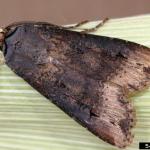Cutworm, Black
Agrotis ipsilon
Black cutworm is the most common of the many cutworm species that damage corn in New England.
Identification:
Adults are night-flying tan and black moths, while the caterpillars are dark-grey to black and up to 2" in length.
Life Cycle:
Moths from the South arrive between March and June. Eggs are laid mostly on grasses and winter annual weeds, usually near areas of the field prone to flooding. Certain fields tend to have a history of repeated cutworm damage.
Crop Injury:
The larvae feed after dark while hiding under the soil surface during the day. There are 2 to 3 generations per year but usually only the first generation, which produces larvae in May and June,damages corn. Small larvae feed on leaves and occasionally larger larvae cut seedlings off near the soil line.
Monitoring & Thresholds:
Adults can be monitored with a yellow and white Unitrap from March through May. A catch of over 40 moths before June indicates that frequent spring and early summer scouting is prudent. Scout problem fields weekly, checking at least 100 plants for leaf feeding and cut stems, especially near field margins.
Cultural Controls & Prevention:
- Ground beetles, parasitic flies and wasps and other general predators help reduce populations.
- When corn follows sod/hay in rotation, fall plowing may lower cutworm populations by reducing spring egg-laying sites.
- Weedy and reduced-till fields tend to suffer the most damage.
Chemical Controls & Pesticides:
Spot spray heavily hit areas or edges of the field if 5% of the plants have been cut down. For best results, make application between midnight and dawn while cutworms are feeding aboveground. Foliar-applied rescue treatments are recommended over preventative soil applied insecticides.
For Current information on production methods (including varieties, spacing, seeding, and fertility), weed, disease, and insect management, please visit the New England Vegetable Management Guide website.
Crops that are affected by this insect:
- Asparagus
- Beans, Snap, Dry, and Lima
- Cabbage, Broccoli, Cauliflower, and Other Brassica Crops
- Carrot and Parsnip
- Corn, Ornamental and Popcorn
- Corn, Sweet
- Cucumber, Muskmelon, and Watermelon
- Lettuce, Endive, Escarole
- Mesclun
- Okra
- Onion
- Peas
- Pepper
- Potato
- Pumpkin, Squash, and Gourds
- Radish
- Rutabaga and Turnip
- Sweet Potato
- Tomato, Field
- Tomato, Greenhouse
The Center for Agriculture, Food and the Environment and UMass Extension are equal opportunity providers and employers, United States Department of Agriculture cooperating. Contact your local Extension office for information on disability accommodations. Contact the State Center Director’s Office if you have concerns related to discrimination, 413-545-4800 or see ag.umass.edu/civil-rights-information.

